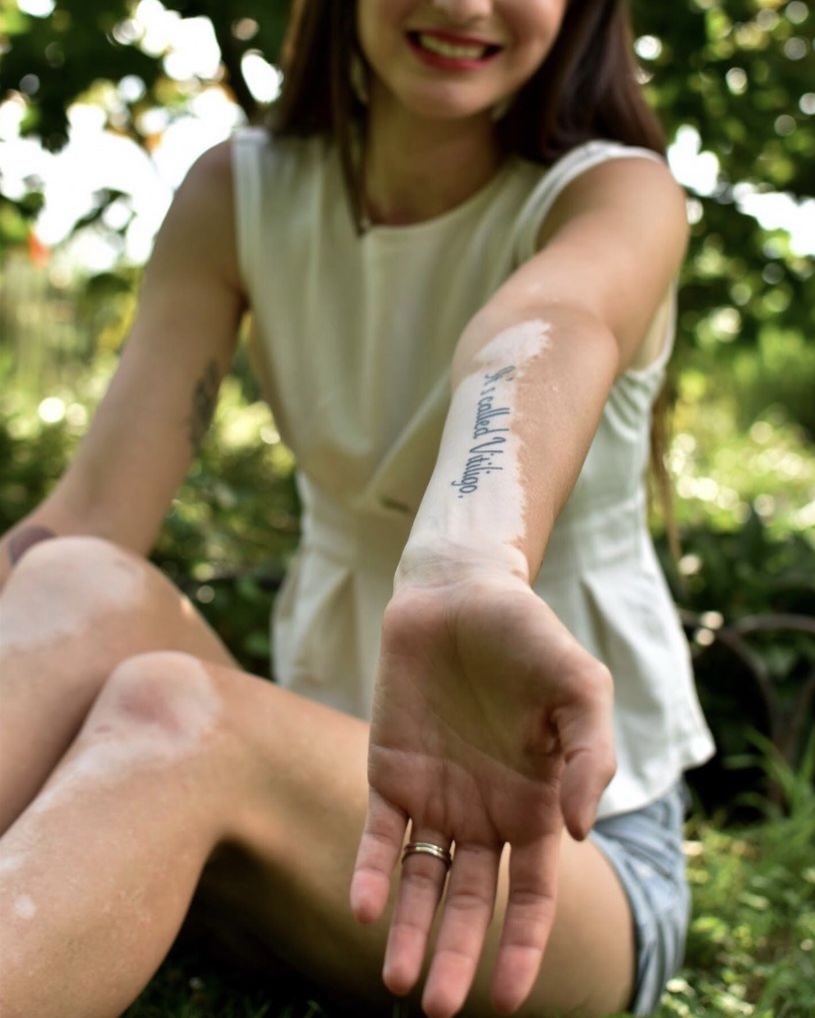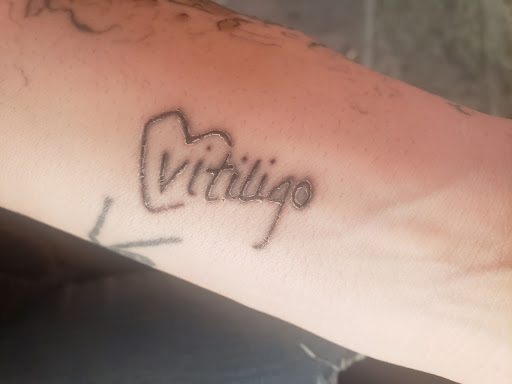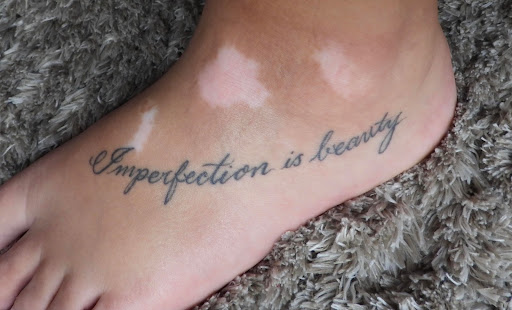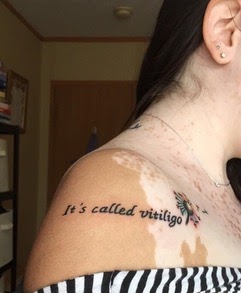5 Women Share the Stories Behind Their Vitiligo Tattoos

Living with vitiligo isn’t always easy. For many, spotted skin attracts stares, comments and questions. For some, the lack of control over skin color can be difficult to accept. But what if you could take back control and help answer questions about your skin all at the same time? That’s what several women with vitiligo have done — by getting tattoos — and gained a personal sense of acceptance and empowerment along the way.
Here several women share their journey with vitiligo and explain what prompted them to take the plunge and get a tattoo.

“I decided to get a tattoo that says, “It’s Called Vitiligo” as a comfort blanket for removing my makeup and spray tan. It’s a way for people to put a name with the condition.” – Tiffany
Name: Tiffany Grant
Age: 31
Location: Brooklyn, New York
Years with vitiligo: 24
Instagram: @itscalledvitiligo.grant
My perception of vitiligo has changed many times over the past two decades. During my primary and high school years, I remember feeling very insecure and was terrified to let people see me as my natural self. But when I was in my mid 20’s, I realized I no longer wanted to be consumed by it.
Six years ago I came across a lady with vitiligo. She was the first person with vitiligo I had ever approached. I admired how confidently she was walking around with her visible white spots. I asked her how she does it. She said, “I have vitiligo, vitiligo doesn’t have me.” This statement was life changing for me. This was the moment I realized vitiligo had so much control over my life. I decided to get a tattoo that says “It’s Called Vitiligo” as a comfort blanket for removing my makeup and spray tan. It’s a way for people to put a name with the condition.

“It is my very own method to express love for who I am.” – Jasmine
Name: Jasmine Abena Colgan
Age: 31
Location: Denver, Colorado
Years with vitiligo: 10
Instagram: @the.spotted.zelephant
I was chosen to be a spotted person in my early twenties. I developed a fear of being different and got behind my camera for comfort. During the early depigmentation days, I found myself documenting my spots and noticing an artistic pattern and form on my skin. Over time I began to reach out to other people who also have vitiligo so that I could document their skin. In 2016, I developed the idea for a non-profit organization, Tough Skin. The words came from my late grandmother who reminded me, “You gotta have tough skin.”
When I was first diagnosed with vitiligo, I felt alone. I had a fear of being so different that no one could relate to a thing I experienced. Little did I know, I was wrong. Developing Tough Skin and exploring the perspective through the spotted lens, I was able to understand that humans are all the same. Skin should be a commonality which brings us together, not something that separates us from each other.
My first tattoo was applied around 2015. I was curious about the idea of controlling the way our skin loses pigmentation. I found that the tattoo gun needle creates a trauma to the skin and that the skin responds to the scarring. I would go back to the artist every six months, but found that getting tattooed on my birthday is a great way to celebrate my life. The artist who tattoos me is Rene Cordero and we have been doing experimental designs for a few years. It has inspired artists such as Pigment Painter to create artwork of my skin. The beauty of embracing who you are can be appreciated by a wide audience. My tattoo has been compared to maps, oceans and graphs. It is my very own method to express love for who I am and become even more spotted with a new way to control my skin.

“I believe vitiligo is an art in itself. This is the reason for getting my tattoo, “It’s called vitiligo,” as it represents full acceptance of myself and the journey that I’ve been on.” – Dionne
Name: Dionne Lees
Age: 25
Location: Malta
Years with vitiligo: 12
Instagram: @dionnelees
I was first diagnosed with generalized vulgaris vitiligo around the age of 13 when I was on holiday abroad with my parents. I woke up with two circles around my eyes and two circles around both of my knees, which then spread rapidly across my body. At first it was a very scary thing. I became self conscious in my late teen years and tried new steroid creams to bring the colour back, but was unsuccessful and found it to be exhausting. I would get teased and people often asked if I had been burned in a fire, which made me dislike my skin even more.
Over the years my perception has radically changed. I have learned to love myself and accept every single one of my white patches. I believe that vitiligo is an art in itself — it’s such a beautiful thing to be different. This is the reason for getting my tattoo, “It’s called vitiligo,” as it represents full acceptance of myself and the journey that I’ve been on. I’ve had a few people ask me what my tattoo means and I use it as an opportunity to educate people about vitiligo and what it means to me.

“By getting the tattoo, I closed the door to all the negativity — in both the past and future.” – Danielle
Name: Danielle Owens
Age: 25
Location: Syracuse, New York
Years with vitiligo: 25
Instagram: @danielle_owens42
I was first diagnosed with vitiligo as an infant when my parents noticed a white patch developing around my right eye. It went away, but as I grew older I began developing more spots. In elementary school, kids asked why I had white spots on my feet or knees and made fun of me for being different. Because of the bullying, I began to see a dermatologist who treated me with pills, topical creams, injections, etc. It wasn’t until recently when I began using UVB light that I had success with treating my spots.
It has taken me almost my whole life to come to terms with this autoimmune disease. I have gone through the bullying, pointing, staring and all the questions. I always felt so different and alone until I came across the Living Dappled community. This group is the first place that has helped me to feel normal and no longer alone in my disease. Vitiligo is not contagious and my spots do not define me as a person. Yes, I am different but that only makes me more unique.
In August 2020, I finally accepted vitiligo as part of who I am and decided to get a vitiligo tattoo. On my left foot I have the quote “Imperfection is Beauty” around my vitiligo spots. These are the same spots that caused the bullying and pointing. By getting the tattoo, I closed the door to all the negativity — in both the past and future. I now feel more comfortable in my own skin. I still get stared at when I’m in a bikini and my white armpits show. But this is who I am and there is no one in the world that looks exactly like me. I have come to love and embrace being different.

“This tattoo is one of the best things I’ve ever done.” – Gabriela
Name: Gabriela Caudill
Age: 24
Location: Appomattox, Virginia
Years with vitiligo: 19
Instagram: @_simplygaby
I was diagnosed between the ages of 5 and 10. My parents brought me to a specialist with the hope that it was not a serious condition. While it was serious to me, it wasn’t life threatening, so my parents made the decision to forgo treatment.
Having vitiligo has never been easy. Making friends was difficult and school was traumatic. The color on my face completely disappeared, aside from some brown pigment around my mouth. People frequently made jokes about chocolate milk and comparing me to different animals or diseases. Thankfully there were people who were kind to me and I remember always being so surprised about it.
As confusing as the depigmentation process was, it became even more confusing when my skin color began to return. Yes you read that right — the color appeared without any treatment. A large part of my skin still has white patches, but most places have freckles that are my original skin color. Some areas – like my legs – have filled in completely.
I have a tattoo with the inscription: “It’s called vitiligo.” The tattoo is in an area where everybody can see. Every day it reminds me of how far I’ve come and that I should never hide. For anyone who stares at me, they will be able to easily understand the reason for my skin. This tattoo is one of the best things I’ve ever done.
Carolanne Wright is a health and wellness writer based in Whitefish, Montana. When not clicking away on a keyboard, she enjoys traveling, trying her hand at a new recipe or hiking about in the woods with her daughter.


